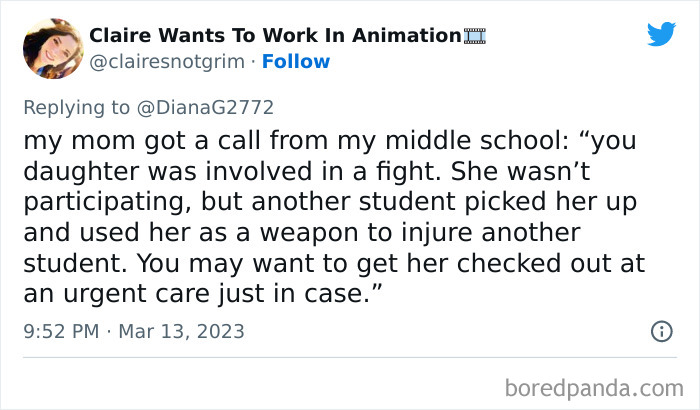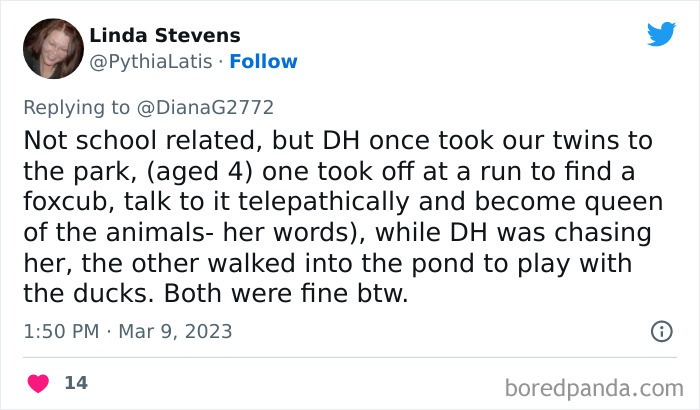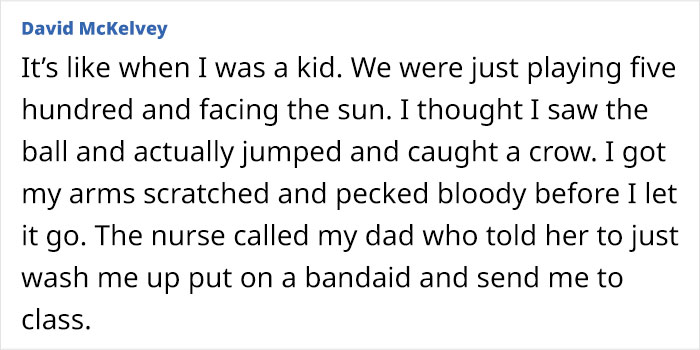Some kids seem to think they’re the main character of a movie when they embark on all sorts of adventures. They might feel they’re in charge or believe themselves to be untouchable. They can also make the executive decision to treat everything around them like a prop; even if it’s a live seagull, for instance.
This exact scenario (yup, a kid successfully caught a seagull after using gummy worms as bait) and other comedy movie-like situations appeared on a recent Twitter thread, started by the user DianaG2772. She told the online community members about her call with the school regarding her daughter’s bird hunting abilities, and they made sure to share their own stories with her. Scroll down to find their humorous accounts below and make sure to have some popcorn ready.
In order to better understand what affects kids’ behavior, Bored Panda discussed this topic with a professor in the department of educational and counseling psychology at McGill University, Dr. Victoria Talwar. Scroll down for our full interview with her.
This post may include affiliate links.
Some things children do might seem unusual or dangerous, but imagine yourself in their shoes—the world was your oyster when you were a little troublemaker yourself. (I sure remember being shouted at for constantly climbing the trees as a kid.) That’s because their behavior is often influenced by experience (or lack of) that we gain over the years.
When we’re little, we don’t have a lot of practice or know-how we can base our actions on. For instance, we might not know that a burn hurts until the first time we touch something hot. Or we might not understand that our feet will get wet if we jump into a puddle before we make a huge splash.
Dr. Victoria Talwar, a Canada Research Chair (II) and a professor at McGill University, told Bored Panda: “Children (and this depends on the child) do not always perceive the risks with some behavior. So they are more fearless when it comes to doing things like climbing high. Adults, on the other hand, have more experience and are more likely to understand the risks.”
In her speech at the MEAB School Leaders’ conference, the course leader on Montessori Education courses at Anglia Ruskin University, Michelle Wisbey, pointed out that a child’s first instinct is to experience everything firsthand. They are believed to have an innate desire to take certain risks in order to challenge themselves and weigh the level of danger against the benefit. That allows them to develop certain skills and make life interesting and fulfilling, according to Dr. Wisbey.
Professor at McGill University, Victoria Talwar, opened up to Bored Panda about her own experience when it comes to this: “When my son was small, when he wanted to climb, I stood close by and was there to help him or to hold him if he fumbled. However, as he grew and gained competence in climbing I stepped back and just watched. I was close enough to come to his aid if needed but I let him climb without my help or hovering right under him.
“As he grew he became very adept at climbing and I was relaxed enough to let him climb large structures or trees with me standing/sitting further away. We need to allow children autonomy and scaffold that as they get older and gain competence/skills at different activities. Of course, there was still risk—he could still fall, but he also had gained ability of climbing and was very skilled at it,” the professor told Bored Panda.
That’s why some argue that it’s important to allow children to face risks to a certain extent. It can help them learn how to properly evaluate such risks and teach them a thing or two about consequences.
Be that as it may, grown-ups should be aware of when to enable the kids’ sense of adventure or when to stop them engaging in certain activities. “We want children to have curiosity and a sense of adventure,” says Dr. Victoria Talwar. “However, we have to offer guidance and limits to prevent harm. Parents/adults need to assess the degree of harm that is likely to occur.
“Some types of activities have a high likelihood of there being harm to the child or another child—running around with a sharp stick. Others may have some degree of risk but we have to manage that—i.e. climbing a medium-size tree.”
Dr. Victoria Talwar emphasized that “there are individual differences for both children and adults. Some people are more fearful and cautious, and others are less so. Also importantly, risk-taking behavior increases in adolescence as a result of changes in the brain (i.e., prefrontal cortex) around the time of puberty which leads to more reward-seeking behavior. It declines in late adolescence and early adulthood as the brain systems mature and develop, and individuals self-regulation improves.”
When running i to forest and getting lost is safer than being in school... progress(sic) in US!!!
Making life interesting is one of the many possible explanations for children’s peculiar activities. They might take action to make it even more fascinating or to attain something that causes joy. Enjoyment falls among the three main driving forces for their behavior distinguished by Joel L. Young, the medical director of the Rochester Center for Behavioral Medicine outside of Detroit. The two remaining ones are acting a certain way to communicate something or to cope with children’s own emotions, such as anger or fear.
Other incentives behind children’s (as well as others’ despite their age, as a matter of fact) actions are often based on one of the five levels of human needs. Developed by Maslow, these levels include physiological, safety, love and belonging, esteem, and self-actualization needs. The latter is the very top of Maslow’s pyramid-like hierarchy. Kids, as well as adults, have the same innate desires, which is why it’s important to understand them and how they can affect the child’s development or behavior.
The developmental psychologist and expert in children’s motivation and behavior Nancy Buck pointed out that the need for safety is biological as well as psychological. “Your children, in all they do, are driven by these same biological and psychological needs. In addition, behavior is purposeful: an attempt to meet one or more of the five psychological needs,” she said. Kids’ actions have to have a goal, which eventually leads to their actions being effective or not. When they’re not, there is no reward and there might be no point in repeating them again.
Some purposeful actions are only effective at the expense of someone else. For instance, taking another kid’s candy might have a purpose and effective outcome, but it’s not the right thing to do. In situations such as this, children are simply following one of their basic human needs, which is why it’s important to let them know that their behavior is not appropriate.
Dr. Victoria Talwar told Bored Panda that it’s important to set certain rules and properly communicate them to the child. “We have to set rules to provide some limits and guidelines,” she said. “For instance, we don’t allow children to play with weapons in the schoolyard because of the degree of serious injury. Just like we have rules about wearing seatbelts in the car for all passengers, we have rules to manage risks.
There is always a risk of driving in a car, but we have rules to limit the potential harm if we get into an accident. However, when giving those rules, it is important to explain them to children so they can develop an understanding of the reasoning. We have to educate children about risks and harms, so that beyond externally imposed rules they can also over time develop a better understanding to be able to judge for themselves and regulate their own behavior as they get older,” she explained.
“As a parent, your job is to help your children learn how to meet their psychological needs responsibly and respectfully,” Nancy Buck emphasized. “Often, the best time to teach children how to meet their needs in responsible and respectful ways is when kids are misbehaving. This is the moment when children are most motivated. They really want what they want and they are willing to learn a different, more effective way to get what they want.”
There might be hundreds of reasons why kids misbehave. According to Very Well Family, they act out because they have big emotions or unmet needs, they’re testing certain limits or trying to show their independence, among other things. By doing this, they might be carrying out their own little research into the world they live in.
The psychologist and author Erica Reischer expands on kids misbehaving in relation to exploring the world in her article for Psychology Today. “When your child appears to be misbehaving, try imagining her wearing a tiny white lab coat and taking notes about the results of her experiment (on you) in an imaginary lab notebook.
“Seeing our children’s behavior through this lens—as an experiment aimed at getting useful information about how people and the world work—can also help us not to take it personally when they push our buttons or ignore us,” she added.
In addition to seeing children as scientists or trying to walk a mile in their tiny shoes, it might be beneficial to pay attention to what they have to say as well. 10-year-old Anyue Sun shared her reasons why parents should listen to kids in her TEDx Talk. The young girl believes that by restricting their child and not hearing what they have to say, the grown-ups become so-called Snowplow parents, which can often lead to certain problems later in the kid’s life.
In her talk, Anyue Sun emphasized that kids need their parents to show support instead of solving everything for them. The Child Mind Institute pointed out that children have to make decisions at all ages; that is why allowing them to practice from the get-go can make it easier to deal with bigger decisions in the future.
When it comes to kids’ actions, sometimes the best thing to do is to sit back and watch (as long as they don’t cross certain lines, of course). It’s not always easy, and their reasoning might seem cloudy at best, but they have to learn and experience certain things on their own. Even if it means using candy to catch a bird.
My son was an escape artist from the time he was 6 months old and soon translated that art into the ability to get into ANYTHING!! At 18 months I found him sitting in front of the fish tank. There was a fish missing. I'm 99% sure he ate it. Not surprisingly 18 years later he was quite the star in his college frat house....
A friend's brother used to catch the goldfish in the tank, dry them with a towel and try to take them for walks. Needless to say the fish didn't appreciate it.
Load More Replies...My kids caught snakes. Doubt many here want to read about those, though.
Load More Replies...I had a 4th grade student who misbehaved on the regular. I had daycare duty and there he was with a cardboard box about the size of a shoe box. I asked him what was in it. A live tarantula he apparently caught on the playground. He was going to get in a daycare bus with a live tarantula and sit behind the driver. I made him go turn it loose in the field by the driveway. Another student, kinder this time, was sucking on something in her mouth. It was after school duty out front this time waiting for a parent pick up. We don't have food at that time of day so I asked what was in her mouth. She said a jewel. I asked to see it. It was a shard of broken coke bottle. She could have seriously cut her mouth up. She cried horribly when I took it away from her. Thought I was stealing her jewel. Let the mom know when she got there. Then there was that time my daughter took her little purse to daycare. Unknown to me she had her markers in it and managed to draw make up on the other kids faces.
Ha! Love the tarantula story. I came home to find 2 coffee cans on table. Opened one to find... scorpions. My boy had been collecting scorpions in the cane fields.
Load More Replies...My son was an escape artist from the time he was 6 months old and soon translated that art into the ability to get into ANYTHING!! At 18 months I found him sitting in front of the fish tank. There was a fish missing. I'm 99% sure he ate it. Not surprisingly 18 years later he was quite the star in his college frat house....
A friend's brother used to catch the goldfish in the tank, dry them with a towel and try to take them for walks. Needless to say the fish didn't appreciate it.
Load More Replies...My kids caught snakes. Doubt many here want to read about those, though.
Load More Replies...I had a 4th grade student who misbehaved on the regular. I had daycare duty and there he was with a cardboard box about the size of a shoe box. I asked him what was in it. A live tarantula he apparently caught on the playground. He was going to get in a daycare bus with a live tarantula and sit behind the driver. I made him go turn it loose in the field by the driveway. Another student, kinder this time, was sucking on something in her mouth. It was after school duty out front this time waiting for a parent pick up. We don't have food at that time of day so I asked what was in her mouth. She said a jewel. I asked to see it. It was a shard of broken coke bottle. She could have seriously cut her mouth up. She cried horribly when I took it away from her. Thought I was stealing her jewel. Let the mom know when she got there. Then there was that time my daughter took her little purse to daycare. Unknown to me she had her markers in it and managed to draw make up on the other kids faces.
Ha! Love the tarantula story. I came home to find 2 coffee cans on table. Opened one to find... scorpions. My boy had been collecting scorpions in the cane fields.
Load More Replies...
 Dark Mode
Dark Mode 

 No fees, cancel anytime
No fees, cancel anytime 




































































































